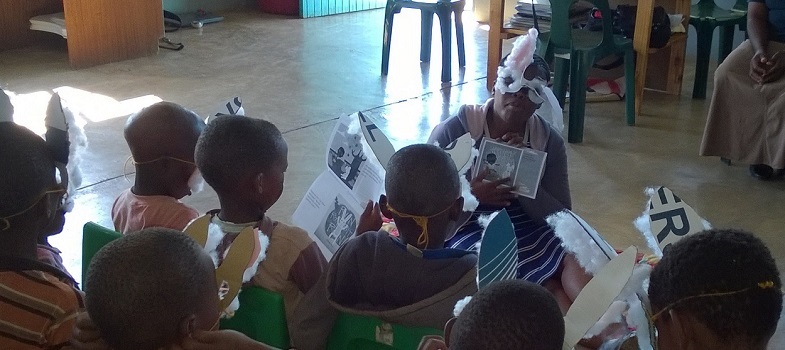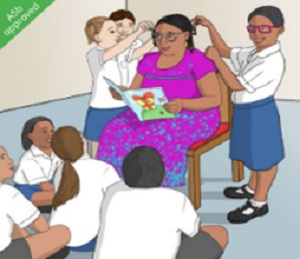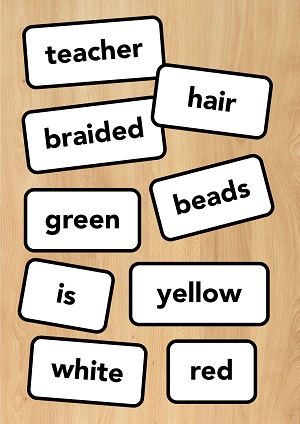Using storybooks to further develop reading skills
In Section 4 you explored different methods for teaching reading. These were:
- letters and sounds (phonemic awareness and phonics)
- look-and-say
- learning experience.
If necessary, go back to Section 4 [Tip: hold Ctrl and click a link to open it in a new tab. (Hide tip)] and remind yourself about those methods. In the next activity you will explore further how you can apply these methods using storybooks.
Activity 5.4(a): Recognising the different approaches
Read Case Study 5.1 below about Ms Khumalo using stories with a group of young readers. It is quite a long case study, so it might help if you read it a couple of times. You can read My Teacher, the story that Ms Khumalo uses, on the ASb website.
While you are reading, use the highlighting tools to identify when Ms Khumalo uses:
- letters and sounds (yellow)
- look-and-say (green)
- the learning experience method (pink).
Case Study 5.1: New words with Ms Khumalo
Activity 5.4(b): Recognising the different approaches
Compare the examples of the reading approaches that you spotted with a friend or colleague. How could you use these ideas in your teaching?
Ms Khumalo’s word wall is shown in Figure 5.2:
Read the discussion below to find out how Ms Khumalo used letters and sounds, look-and-say, and the learning experience method.
Discussion
- Letters and sounds: Ms Khumalo works with ten children, focusing on recognising the sound associated with ‘b’, picking out and sounding words in the story than begin with ‘b’.
- Look-and-say: Ms Khumalo works with a group of 20 children and reads the story with cards that highlight key words. The emphasis is on helping children to recognise the words through linking them with the pictures.
- Learning experience: Throughout the session, Ms Khumalo relates the story to children’s experiences and encourages them to draw pictures of the words. This will help their comprehension of the words.
Selecting stories for a purpose
Different stories support the three methods and as you gather experience you will be able to pick out stories that are suited to each method.
In the next activity you will analyse one of the stories you found in Section 2.
Activity 5.5: Selecting stories for a purpose
- Choose one of the stories that you found in Section 2.
- Which of the three methods from Section 4 could you use with this story?
- Discuss the story and the methods with your colleagues.
- In your study notebook, briefly describe an activity using the method(s) that you will do with the children. Use this structure to write your description:
- Name of story:
- Method:
- What will the children learn?
- What will the children do?
- What will the teacher/you do?
- Where in your lesson plan will you do this activity?
Different storybooks can be used in different ways. As you develop your confidence you will be able to choose stories that are particularly suitable for different methods.
Optional activity: You can use the downloadable resource ‘Choosing stories for different purposes’ to find stories that you can use in your class. Spend some time looking at the stories suggested and thinking about how you could use them.
Using storybooks to develop thinking skills





